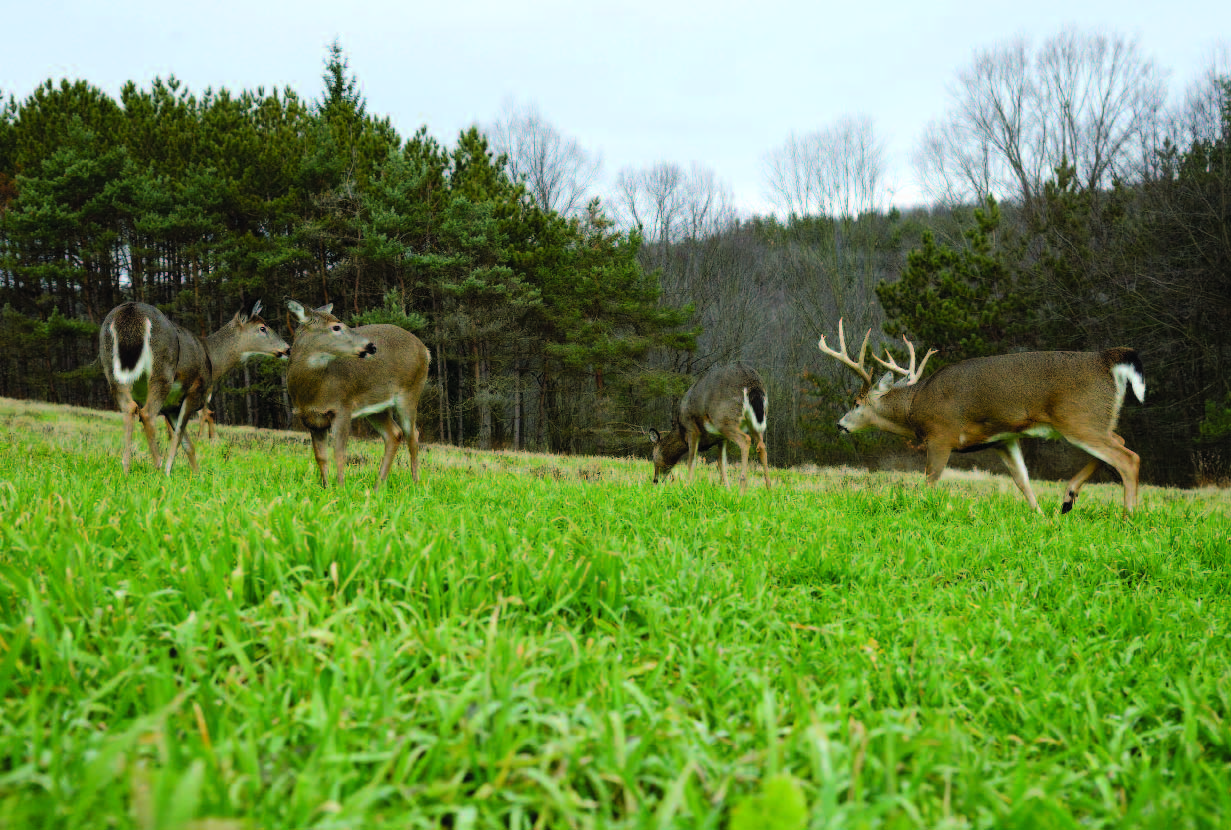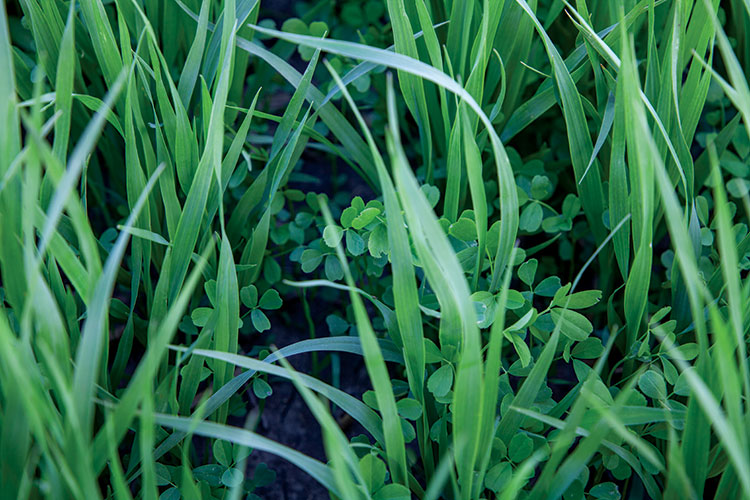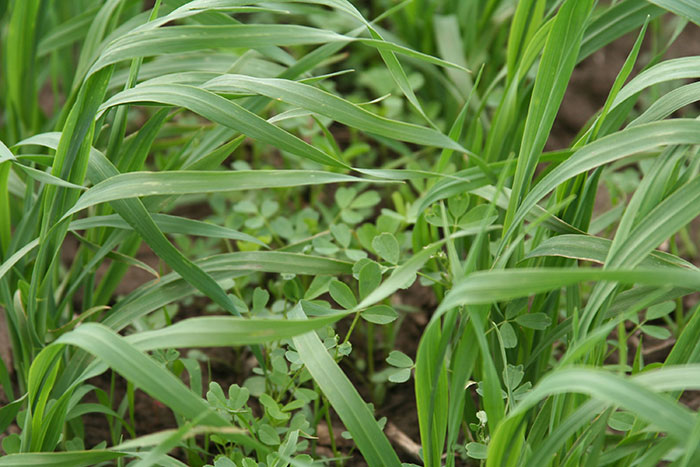The Perfect Cover Crop for Fall Perennial Plantings Offers Many Benefits
By John Cristinziani

In Canada, getting your hands on herbicides to control pesty weeds in your perennial plots of clover, chicory or alfalfa can be an adventure on its own. After-all, those who have tried to grow perennials in the spring and summer quickly realized how those nuisance weeds can interfere in establishing a successful perennial plot. Spring and summer are peak weed seasons.
For those less up-to-date on the laws, herbicides are illegal in Canada unless you are licensed to buy and use them. There are courses offered for a sum that will grant you a license but not everyone is ready for that sort of a commitment. Let’s face it, if we can avoid doing so, even those of us who are licensed just don’t care to use herbicides and not interested in spraying them in our plots or in manipulating them all together

Some of us may have missed the spring and summer planting dates for our perennial plantings, but believe it or not, you are still Not Too Late to get those clovers and chicory plants in the ground now for next year. Yes, I did say for next year!
If you’re planning to plant a perennial food plot this fall like clover or chicory or alfalfa, consider planting Whitetail Oats Plus with your perennial of choice as a cover crop.
What is a Cover Crop? We hear it all the time from our farmer friends or on television or from all the food plot guru’s out there, but what exactly is it?
A Cover crop is basically a fast-growing secondary crop that is planted with a primary crop, in this case, Imperial Whitetail Clover, Alfa-Rack Plus or Fusion in the same seedbed. Nothing beats Whitetail Oats Plus when it comes to cover crops to plant with these perennials in the fall!
The many benefits:
A cover crop with Imperial Oats Plus creates the fastest possible attraction:
Several characteristics of Whitetail Oats Plus make it an ideal choice for a cover crop with a perennial planted in the early fall. First, all Whitetail Institute food plot seed components are evaluated for rapid emergence and seedling vigor. That’s why all Whitetail Institute food plot products can appear above ground so soon after planting. Whitetail Oats Plus can do so even more quickly and, when planted as a cover crop, will help the food plot green up more quickly and start attracting deer soon after planting. How cool is it to have an almost immediate fall attractant annual plot with Whitetail Oats Plus and also be ahead of the game for your upcoming perennial plot for next spring!
Additional Drought Protection:
A cover crop of Whitetail Oats Plus also works in combination with Rainbond, which is included in the seed coating on the legumes in the Whitetail Institute perennials mentioned earlier. No other food plot seed company offers this coating. Rainbond protects the seed from germinating on comparatively small amounts of moisture (in some cases, even just with heavy dew) when there’s insufficient moisture in the soil to sustain the seedling. Rainbond also continues to benefit seedlings after germination by helping maintain a more consistent supply of moisture. Rainbond acts as a mini-reservoir of water by absorbing up to 200 times its weight in water from the soil and drawing in more moisture from the soil as the seedling uses it. And because Rainbond is in the applied seed coating, it remains where the seedling is growing so the seedling has ready access to the moisture. Planting a cover crop of Whitetail Oats Plus with these perennials in fall is a great way to hedge your bets against the chance that Mother Nature will turn off the rain in late summer or early fall, which can slow the growth of the perennial. The plants in Whitetail Oats Plus also have fibrous roots, which help hold the soil in place while the perennials establish themselves. Whitetail Oats Plus also creates a microenvironment of higher humidity near the soil surface that helps reduce evaporation of moisture from the soil. This microenvironment, coupled with the water-holding benefits of the Whitetail Institute’s Rainbond seed coating, can provide even greater protection for the perennial seedlings as they sprout and grow.
Sustained Attraction:
Whitetail Oats Plus doesn’t just provide benefits during the first month or two after planting them with a perennial in fall. They continue to boost attraction by adding variety to the stand.
Seedbed Preparation for a Fall Perennial with a Cover of Whitetail Oats Plus:
Preparing the seedbed and planting a perennial with a cover crop of Whitetail Oats Plus is easy. You’ll just need to adjust the seeding preparation and planting instructions a little, as follows:
As with any forage planting, it’s best to have your soil tested by a qualified soil-testing laboratory to determine exact lime and fertilizer requirements. If possible, have your soil tested several months before planting so you can add any lime recommended and disk or till it into the seedbed well before planting. When you submit your soil sample to the lab, have the lab test for establishment of the perennial you’ll be planting, not for the nurse crop. If no soil test is performed, add a minimum of two tons of lime per acre to the seedbed. Do not skip this step. Making sure soil pH is neutral (6.5 or higher) is the most important factor you can control to ensure food plot success. Remove as much of the grass and weeds from the seedbed as possible by disking, tilling and/or spraying.
Planting Instructions
Step 1. When you reach your planting date, start by disking or tilling the soil. Then, before smoothing the disked or tilled seedbed, put out the fertilizer (as called for in your soil-test report, or 400 pounds of 17-17-17 or equivalent fertilizer per acre if you didn’t do a soil test), and broadcast the Whitetail Oats Plus seed at a seed rate of 30 to 45 pounds per acre.
Step 2. After you have put out the fertilizer and Whitetail Oats Plus seed, drag the seedbed to lightly cover the Whitetail Oats Plus seed. This will also smooth the surface of the seedbed sufficiently to prepare it for planting the perennial seed. A cultipacker is not required, but if you have one, it’s OK to cultipack instead of dragging to complete this step.
Step 3. When the seedbed has been smoothed, broadcast the perennial seed of your choice at its full seeding rate (shown on the front of the bag).
Step 4. Do not cover the perennial seed. If you used a drag at the end of Step 2, do nothing more after you put out the perennial seed. However, if you used a cultipacker at the end of Step 2, cultipack the seedbed again after putting out the perennial seed to help it establish good contact with the soil. With Mother Nature’s cooperation, your cover crop of Whitetail Oats Plus will emerge quickly, and you’ll see the perennials emerging soon after.
The benefits continue the following year...

Because the Oats were planted in the early fall, they never had a chance to go to head creating seeds. So come spring time, the Oats will begin to grow a second time along with the perennials you planted last fall. As all the plants continue to grow, the Oats will eventually over-take the perennial plants as they grow much more aggressively and faster than the perennials do. But in doing so, they are providing a great shield for your perennials and will choke out many of the weeds that are also trying to come up in competition with your plants. All that is left to do in mid to late May is to mow down the Oats which in turn will kill the Oat plants. A little added fertilizer will then allow your perennials to come up nicely with much less weed competition and the Oats that die will eventually be filled in with the perennials plants that you are trying to establish.
Frost seeding a little more perennial seeds in late winter or very early spring...
As an additional tip, you may consider doing a little frost sending with some of the perennials during the late winter or early spring while the ground is still freezing at night and thawing during the day. Topping off the cover crop with a little more Imperial Whitetail Clover or Imperial Fusion will help to quickly fill in the bare spots that may be left behind with the Oats that are dying off once you have mowed them off. (For more detailed information on Frost Seeding read: Frost Seeding Time is Here)
So if you missed your opportunity at planting some perennials in the late spring or early summer or are simply trying to capitalize on establishing an amazing fall planting plot for this year while being ahead with your perennial plot for next spring, you still have time. Sept. 1-15 are the best planting dates in Eastern Canada. While August 1-15th work best in Western Canada.
Planting cover crops definitely offers benefits that are worth considering. It may be the new way of establishing successful plots of clovers and chicory and alfalfa without the constant competition of those irritating weeds.
